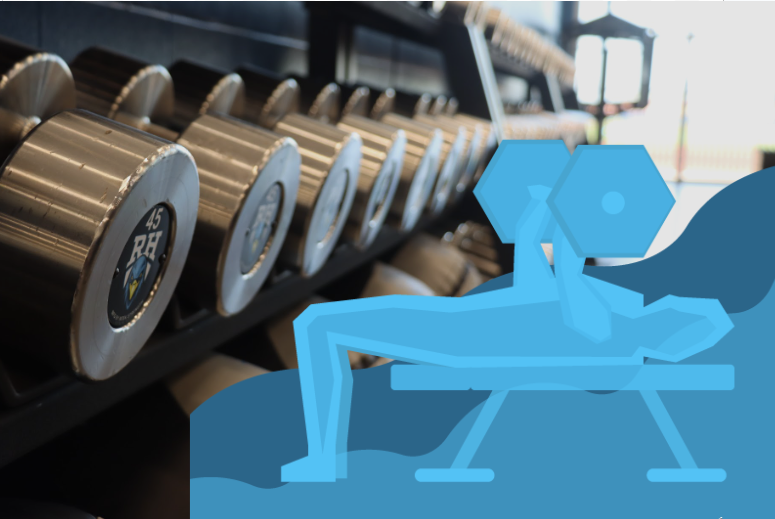Gym popularity has surged since the pandemic as people began returning to their lives after quarantine. Many focused on improving their mental health, as the pandemic “brought about a sense of fear and anxiety across the globe,” the National Library of Medicine said.
“A lot of people were forced to take a second look at themselves and how they were treating themselves,” senior Alexander Jones said. “These people are now looking for people to help improve their lives. So the fitness influencers who were already on social media are being shown to a bigger audience, which makes it spread like wildfire when everyone’s at home on their phones.”
As a result, exercise, an accessible form of self care, became more popular. Similarly, IHRSA, The Global Health and Fitness Association, reports a 3.8% growth in gym memberships across the United States from 2020 to 2022.
“It really helps my mental state,” Jones said. “If I don’t go to the gym in a few weeks I start feeling depressed again. It’s the biggest positive influence on my life. I’ve struggled with really bad depression in the past and I feel like the gym has helped me more than any medication could.”
Physical activity can help to manage stress and by reducing cortisol levels and increasing the production of endorphins, the body’s natural painkiller. According to Healthline, “Pain triggers your brain to release endorphins. These hormones alleviate pain and induce feelings of pleasure.”
“I like going by myself because it’s unwinding after being in a big social environment all day long,” junior Anna Williams said. “Going to the gym makes me feel accomplished, like I’ve done something with myself and helps me relieve stress.”
Recently, aspects of ‘gym culture’ have circulated across social media. One such example is the use of pre-workout.
What is pre-workout?
Pre-workout supplements are fairly new to the fitness market, as the first product, Ultimate Orange, was created in 1982. Unlike protein powder, these powders and capsules contain little to no protein. Instead, they are carefully crafted blends which often include amino acids, vitamins, creatine and sometimes caffeine.
“I’ve started to move away from pre-workout,” Jones said. “I used to take it constantly, but because of how much caffeine there is, I don’t feel like it’s good for me long-term.”
There are two main categories of pre-workout: ‘stim,’ which contains caffeine and ‘non-stim,’ which has no added stimulants. Both are designed to increase endurance and focus during a workout, although there has been little evidence to suggest their effectiveness.
“I use pre workout and I like having the extra energy because sometimes I’m drained after school,” Williams said. Williams prefers to go to the gym in the hours after her early release period.
According to an article by Verywell Fit, “In terms of exercise performance, research suggests that pre-workout supplements can increase blood flow in the muscles but only during high-intensity workouts.”
“It doesn’t make that much of a difference for me in terms of how much fun I have, Jones said.” Since Jones prefers to workout at night, he has strayed from pre-workout, as the caffeine keeps him from getting a good night’s sleep.
Caffeine stimulates the nervous system by boosting adrenaline which peaks an hour after consumption but remains in the bloodstream for up to 10 hours depending on the amount. Stimulant pre-workout supplements contain anywhere between 150 and 300 milligrams of caffeine, or 1.5 to three eight ounce cups of coffee.
“I don’t take the full scoop because it has a lot of caffeine, but I feel like it does help. I can actually see a difference even though it’s only been a month,” senior Vanessa Sherpa said.
Despite the widespread use of pre-workout supplements, effectiveness can vary and scientists know very little about their long term effects on human health.
The push and pull of gym pressure
As workout and weight loss videos gain views on social media, more and more people begin to rethink their own health and body image. Some report the presence of fitness influencers to have a positive influence on their motivation to achieve their goals while others find them to be pressuring and unrealistic.
“On social media there’s a whole environment based on self improvement rather than what other people believe you should be,” Williams said. “The effect of fitness influencers can go both ways. If you have a really low self image, you can see people who are at the point you wish you could be some day which can cause you to fall into a dark place. But if you see people on the same track as you, it can be empowering.”
The effect of fitness influencers, whether positive or negative, is magnified for teenagers, as young brains are more impressionable than mature adults due to their synaptic plasticity. Additionally, the most active part of the brain during adolescence is the amygdala, which is associated with fear, emotions and motivation.
“Sometimes I get nervous,” Sherpa said. “I will be using a machine and think ‘what if I’m doing this wrong?’”
Though exercise is meant to be accessible to all, some trends can limit information flow and prevent people from maximizing their experience. Both workout videos and gym equipment can be intimidating to beginners due to garbled gym terminology and unclear instructions.
“Know that you don’t need to understand everything right away. Don’t be afraid to look things up and ask for help because everyone started at the same place,” Williams said.
External factors such as bullying also play a big part in many gym-goers’ motivation.
“I was out of shape and got bullied for it a lot in middle school,” Jones said. “I really didn’t like how my body looked, and it just constantly stuck with me.”
Jones has since joined the water polo team, which pushed him to go to the gym on his own time.
“I’m in a lot better shape now and I know that,” Jones said. “I’m more disciplined and confident in how I look. I think there’s always more to go, but my body image has gotten a lot better.”
Internal pressures such as the struggle to maintain a consistent workout routine are common among gym-goers, as indicated by the 2020 ISHRA Global Report which found that gyms lose 50 percent of all new members within the first six months.
“Sometimes I have to force myself to go,” Sherpa said. “Because if I don’t I won’t get to where I want to be and then what’s the point?”
Another facet that can hinder self esteem at the gym is muscle dysmorphia or MD, a category of body dysmorphic disorder (BDD) in which someone perceives themselves as less muscular than they actually are. According to Healthline, MD is most common among male bodybuilders with a “build that’s average or more muscular than average.” Although not everyone struggling with body image relating to muscular build automatically has muscle dysmorphia, unrealistic expectations in the media perpetuate preexisting insecurities which may appear similar to MD.
“Some days you can see yourself as way worse than you actually are and it’s hard to pull yourself out of that and be like ‘I am making progress. I am getting better,’” Williams said.
According to D’Amore Mental Health, between 5.5 and 9.6 million Americans suffer from body dysmorphia. In accordance with high measures of BDD, a 2022 study done by Science Direct confirms the direct and indirect relations between body dissatisfaction and the use of TikTok.
“A lot of the fitness influencers out there aren’t good to listen to,” Jones said. “I hear a lot of ‘you can achieve this’ but really you can’t. It’s either really, really good genetics or they’re on some sort of trend. There’s no point in telling someone they can achieve something near impossible.”
New gym-goers, especially, sometimes feel as though they are being judged during their workout, which can discourage them from attending.
“A lot of people who I’ve talked to feel threatened to go to the gym because they feel like everyone would be looking at them,” Jones said. “But honestly everyone else there is also on their own personal journey. In the nicest way possible, no one cares.”












![A digitally constructed image shows money flowing out of a U.S. government building, representing the economic impact of the Trump administration’s new tariff policy. “[The tariffs are] supposed to basically pump up American businesses to where Americans go buy American products,” U.S. government teacher Adam Barclay said. “Then you have more manufacturing, you have more jobs, and that's how it's supposed to work.”](https://rockhillmedia.org/wp-content/uploads/2025/04/Impact-of-the-U.S.-Tariffs-1-1200x675.png)




